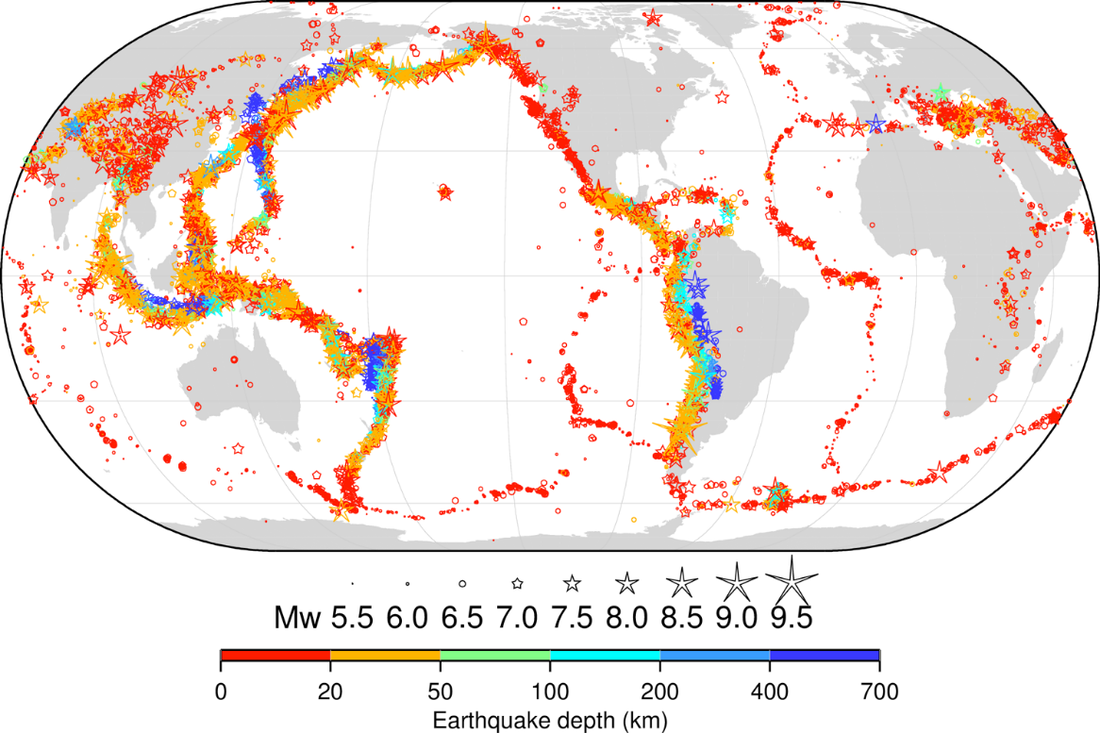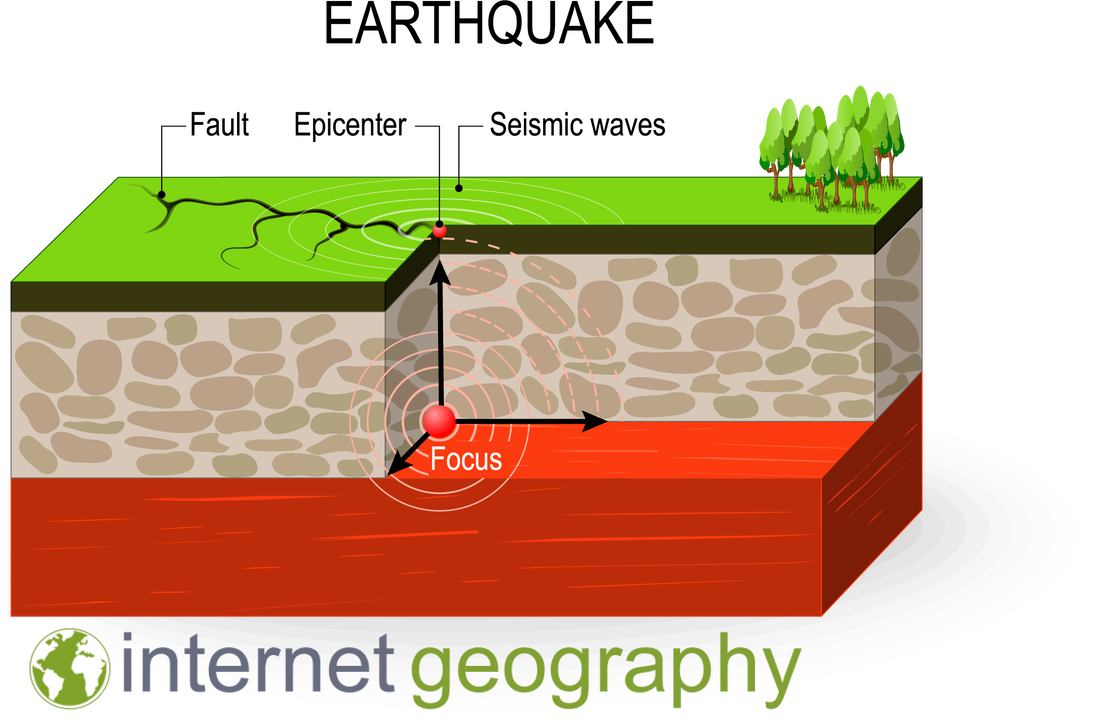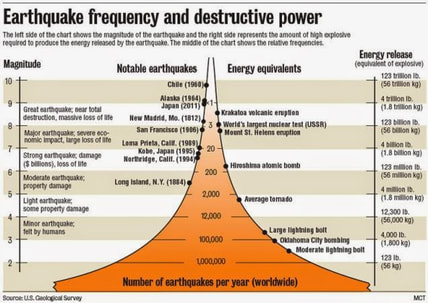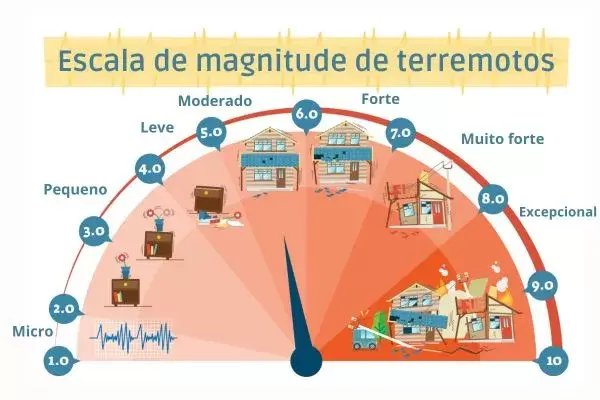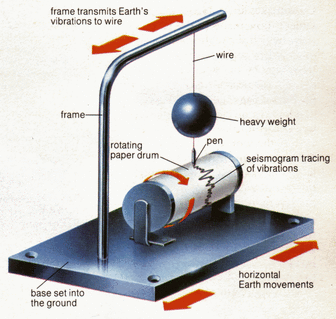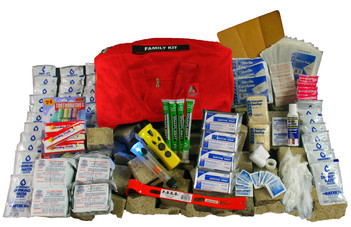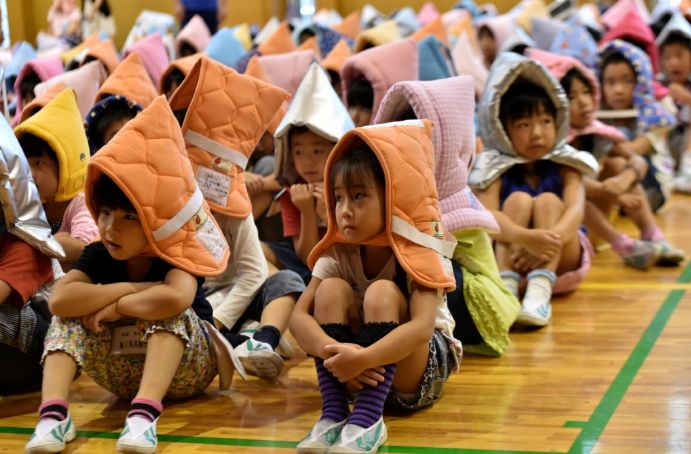The Earthquake Through My Eyes
|
Objective: To try to use our imaginations to write about and draw the damage that an earthquake could cause.
Credit: Tony Cassidy. Task 1 - How would you feel? - Study the presentation below carefully and then watch the video below. Complete the first adjectives activity on a digital copy of worksheet 1. Task 2 - Completing the drawing task using a paper copy of worksheet 2 below. Task 3 - Complete your written task for a local newspaper. Go back to worksheet 1 and use the space provided to complete the activity. |
In grammar, an adjective is a 'describing' word |
Where Do Earthquakes Happen?
Task 1 - Using the map and video above, describe the pattern of earthquake activity around the world.
Task 2 - How does this link in to the location of major plate boundaries? (remember tectonics & volcanoes?).
How Do Earthquakes Happen?
Task 1 - What is the difference between the focus and the epicentre of an earthquake?
Task 2 - Using the worksheet below, explain with the aid of a diagram how earthquakes happen.
You should aim to use the following words in your description.
conservative plates, friction, stress, slip, focus, epicentre, seismic waves
How do Earthquakes Cause Tsunami Waves?
The word tsunami (pronounced tsoo-nah'-mee) is composed of the Japanese words "tsu" (which means harbour) and "nami" (which means "wave").
Starter: Watch the video above - an introduction from National Geographic to the phenomena of the tsunami.
Task 1 - Download a copy of the reading comprehension worksheet* below and complete the answers on a separate Word document
Task 2 - Check out Google Street View above.
i. What do think this wall is for?
ii. What is on the other side of the wall?
iii. Turn round and find the large white building behind you. This is going to be important later.
Task 3 - What happened to cause the devastating tsunami that struck the east coast of Japan in April 2011. Your starting point is to watch the three minute science video below
i. What do think this wall is for?
ii. What is on the other side of the wall?
iii. Turn round and find the large white building behind you. This is going to be important later.
Task 3 - What happened to cause the devastating tsunami that struck the east coast of Japan in April 2011. Your starting point is to watch the three minute science video below
Task 4 - Now watch the footage of the wave hitting an estuary and the fishing port of Miyako, minutes after the earthquake happened. Watch how fast the scene turns from relative calm into total devastation! Do you recognise that scene?
Task 5 - Now watch some incredible aerial footage taken from a news helicopter and broadcast live that showed the tsunami arriving in a coastal area. You will need to watch only the segment from 17.26 to 19.10.
Task 6- Create a fact file about the 2011 Japanese tsunami. You should include:
1. The plate boundaries that caused the quake
2. How the earthquake caused a tsunami
3. How quickly did the tsunami take to reach the coastline
4. What protection methods had been built to stop a tsunami and did they work?
5. How did they try to warm people about the oncoming tsunami
6. What damage was caused by the earthquake?
7. How many people lost their lives?
8. What happened at Fukushima?
9. How well has the country recovered after the disaster? - Check out this before and after link!
How are Earthquakes Measured?
How Do People Respond To Earthquakes?
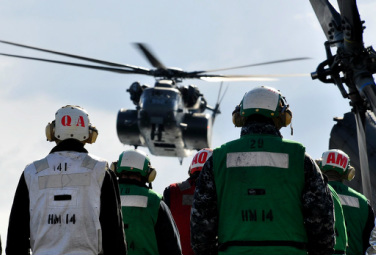
Objective: To complete a 'living graphs' exercise and to find out about the different ways in which people can respond to the threat of a big quake.
Starter: What happens during an earthquake?
In pairs, complete this living graph exercise. You might want to check out the YouTube video below first to show you how a seismograph works.
Extra - As you are completing these tasks, your teacher might say a certain word or show this presentation*. Get to a safe place as soon as possible. Where could that safe place be?
Starter: What happens during an earthquake?
In pairs, complete this living graph exercise. You might want to check out the YouTube video below first to show you how a seismograph works.
Extra - As you are completing these tasks, your teacher might say a certain word or show this presentation*. Get to a safe place as soon as possible. Where could that safe place be?
How Do You Keep Safe During An Earthquake?
|
Scheme 1 - Earthquake Survival Kit.
Click on the picture to the right to enlarge it. Identify five things that you recognise and write down why they would be useful to help you to survive after a quake. Click here to be taken to the task sheet. |
You live in Japan. Following on from the last major earthquake in 2011, the plate boundary on which Japan lies has been showing signs of activity. The Japanese Prime Minister has told all local people to put together an earthquake emergency kit that would be useful in the event of another earthquake.
Extension Task - You have been commissioned to create an educational poster for a primary school in Kobe, Japan. The government want you to produce a poster that will be put up in every classroom in every school in the city.
The poster should show students and teachers what they need to do at the first sign of an earthquake.
Remember, many of the students are very young and can't read, so you will have to use plenty of visuals to help their understanding.
Scheme 2 - Designing An Earthquake Resistant Building.
Study this PowerPoint carefully reading the text and studying the pictures and diagrams carefully. Credit: V Kent.
Task Sheet & Grades - Click here. Credit: Caroline Room
PowerPoint Presentation - Click here Credit: Profmaker
PDF Planning Sheet - Click here
Study this PowerPoint carefully reading the text and studying the pictures and diagrams carefully. Credit: V Kent.
Task Sheet & Grades - Click here. Credit: Caroline Room
PowerPoint Presentation - Click here Credit: Profmaker
PDF Planning Sheet - Click here
Background Research Videos
|
1. Base Isolation
|
2. Braces & Water Tank
|
3. Escape!
|

